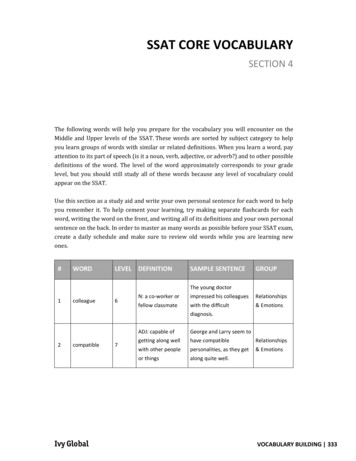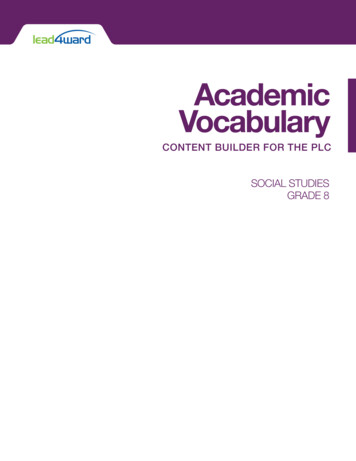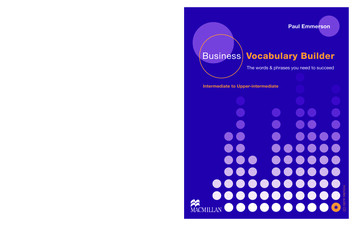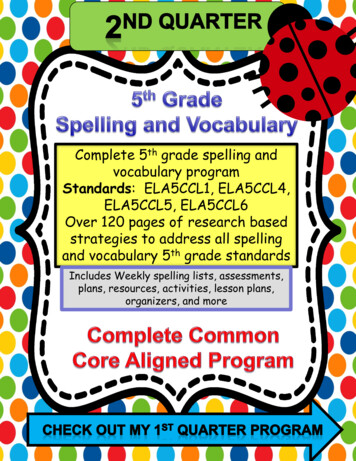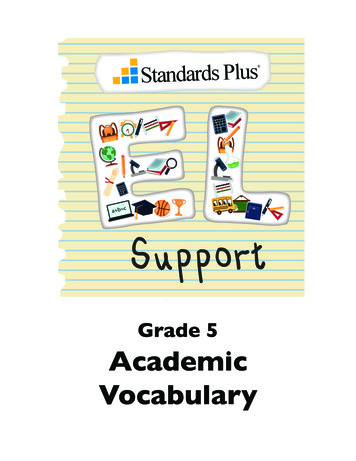
Transcription
Standards Plus Su pp or tGrade 5AcademicVocabulary
What is Academic Vocabulary?Academic Vocabulary includes the words, phrases, and language structures thatare used in learning. It includes the formal language that is used in education,whether orally, in textbooks, and in assessments.Academic Vocabulary is distinct from the informal language that is used at home,on the playground, and in daily conversation. Slang and colloquialisms are not partof academic vocabulary. Students may be quite adept with the English languagein the informal register long before the academic register is developed. It takesspecific instruction to build academic vocabulary.2www.standardsplus.org 2011 Learning Plus Associates
5th Grade Mathematics TeachingAcademic VocabularyLesson Index with Language ObjectivesThere are three methods of teaching academic vocabulary, and all three are necessary forvocabulary development. Explicit instruction of words, explicit instruction ofword-learning strategies, and indirect instruction of vocabulary are all essential to developing academic vocabulary.In explicit instruction of words, teachers select terms that are taught using definitions,examples, and proper usage. These terms may be content-specific (e.g., addend, subtrahend)or conceptual (e.g., summarize, explain). This instruction includes using the terms in contextand multiple exposures to cement the learning. If word banks or vocabulary notebooks areused, these are the terms that are included with definitions, usage, and non-linguistic representations to help the learner remember the term and its meaning and usage.In explicit instruction of word-learning strategies, teachers introduce, model, and prompt for the use of strategies that are used when a student comes to an unknown word. Context clues, word parts, cognates, text features, and related words are usedto help the student attach meaning to the unknown word. Students must practice usingthe strategies across the curriculum whenever they are presented with unknown words.For the English Learner, special attention must be given to helping him determine which arethe important words. Names and poetic or flowery description can be difficult to navigate,but may not be essential for comprehension of the big ideas being presented.In indirect instruction of vocabulary, students are exposed to language through discussion, reading, being read to, multimedia resources, and education-related experiences. Thisis a very natural way to learn language, but it also varies widely depending on the languageexperience of the student.www.standardsplus.org 2011 Learning Plus Associates3
Reinforcing Academic Vocabulary InstructionStudents should record terms that are taught directly. The record of the terms should be ina format that the student can easily access and understand. The vocabulary may be collectedin a notebook, on note cards, in word banks, or other collections, but they must have meaningfor the student. If each student has an individual record of the terms, leave room for newinformation. Students should add new concepts, deeper meaning, graphics, or new usages tothe record as the vocabulary develops.When a term is revisited or a new or deeper meaning is explored, the students should beprompted to record the new learning. Students may also use graphic organizers to help themsee the connections between related terms. This is especially helpful when studying a topicwith many academic vocabulary terms. The Standards Plus EL Portal has manygraphic organizers that can be used. Each graphic organizer is presented in a blankformat and a completed format as an example of how it may be used: Concept webConcept treeVenn diagramOrganized ListIdea handGames are an engaging way to revisit vocabulary, and a few simple games can be used all yearwith different sets of vocabulary. Vocabulary Bingo can be set up so that the students listenfor vocabulary terms or their definitions. The bingo cards may have a different term writtenin each square, or they may have a different definition in each square. The teacher can callthe definition of the term, and the students must mark the matching term, or the teachermay call the term itself, and the students must mark the definition that goes with the term.Examples of these two types of bingo games are found in the StandardsPlus EL Portal . Charades or picture charades work well for terms that can be acted outor drawn. Crossword puzzles and rebuses are great for review, too.4www.standardsplus.org 2011 Learning Plus Associates
Reinforcing Academic Vocabulary InstructionIn the spirit of competition, students can compete for class, table, or personal “points” for finding or using academic vocabulary. For example, a student may come in from the playgroundand say, “Wow! A lot happened at lunch today. Let me summarize what happened ”If summarize is a term that the class is studying, the class, that student’s table group, or thestudent could earn a “point” for correct usage of an academic vocabulary term. Students mayalso earn points for finding academic vocabulary terms in reading material, hearing academicvocabulary terms that others use, or using them in their writing.www.standardsplus.org 2011 Learning Plus Associates5
Grade 5Language Arts - Academic VocabularyAAct: Large portions of the play.Adage: A statement or saying that expresses something that is generally understood as the truth.Affix: A word part that is added to the beginning or end of a root; a letter or letters added to aroot or base word.Antonym: A word that has an opposite meaning.Article: a, an, the.CCast of Characters: A list of the characters in a play.Cause and Effect: One act or event that leads to something else happening; a relationship in whichone thing causes another to happen.Chapter: A section of a book.Characters: People in a story.Chronological: When the ideas or information are presented in time order.Clause: A group of words that has a subject and a verb.Compare/Contrast: Identifying the similarities and differences between two or more people,places, things, or ideas.Comparison: A relationship in which two different things are analyzed to determine similarities anddifferences; how things are alike and how they are different.Concluding Sentence – Opinion: The final sentence that restates the topic and ties together thereason the author holds his/her opinion.Conclusion – Informative/Explanatory: The final sentence or paragraph that restates the topic andlets the reader know that the text is complete.Conclusion: How the story ends; the closing of a written text that ties all of the ideas together.Conflict: A problem the characters must solve.Conjunction: A word that joins clauses.Context: The words and ideas around unfamiliar words.Context Clues: Words before or after an unfamiliar word that give clues about its meaning.6www.standardsplus.org 2011 Learning Plus Associates
Grade 5Language Arts - Academic VocabularyCoordinating Conjunctions: for, and, nor, but, or, yet, so.Correlative Conjunction: Conjunctions that connect information: neither/nor, either/or, not only/but also, both/and, not/but.DDetail: Information that describes or explains an idea in text; information that further explains areason; information that supports the main idea.Dialogue: What the characters say.Direct Address: When a speaker or writer directly addresses a character or person and calls himor her by name.Drama: A play or story.EEvents: Things that happen to the characters; the action or what happens in a story.FFact: True information.Firsthand Account: Told by someone who was there; uses the pronoun I.First Person: Point of view that uses I and we.Functional Documents: Documents we use in our daily lives.Future Perfect Tense: A verb tense in which the action will have occurred before another event inthe future.Future Tense: A verb tense in which the action has not yet happened.HHomograph: A word with the same spelling but a different meaning than another word.Homophones: words that sound alike, but have different meanings and may be spelled differently.Hyperbole: A figure of speech in which something is greatly exaggerated.www.standardsplus.org 2011 Learning Plus Associates7
Grade 5Language Arts - Academic VocabularyIIdiom: An expression that has a meaning other than what the words literally mean.Inference: A conclusion you reach based on what you read.Informational Text: Text that informs, explains, or teaches about a topic.Informative/Explanatory Text: Text written to inform the reader or explain a topic.Interjection: A word used to show some sort of emotion.Introductory element of a sentence (introductory clause): A word or a phrase that introduces asentence.The introductory element can be as short as one word or have many words.MMain Idea: The central point of a passage or text.Metaphor: A figure of speech that compares two unlike things to show a similarity; a direct comparison of two different things.NNarrative Writing: Text written to entertain or relate events.Narrator: The person telling the story.OOpinion: How you feel about a topic.PPast Perfect Tense: A verb tense in which the action occurred before another event in the past.Past Tense: A verb tense in which the action has already happened.Perfect Verb Tense: A verb tense in which the action has already occurred.Personification: Assigning qualities of a human to something that is not human; a figure of speech inwhich inanimate objects or animals are given human qualities.Phrase: A group of words that does not have a subject and a verb.Plot: How the characters, events, and setting interact in telling the story.Poetry: Literature written in lines of verse.8www.standardsplus.org 2011 Learning Plus Associates
Grade 5Language Arts - Academic VocabularyPoint of View: An attitude, opinion, or judgment. The perspective from which a story is told; outlook or attitude of the reader or writer.Precise Language: Specific words used to help the reader picture what he/she reads.Preposition: Words that link nouns and pronouns to other words; tell where, how, or when something occurred.Prepositional Phrase: A phrase that begins with a preposition and usually tells when or wheresomething happened; a group of words that begins with a preposition.Present Perfect Tense: A verb tense in which the action has occurred before this moment in time.Present Tense: A verb tense in which the action is occurring now.Problem/Solution: A structure that identifies a problem and suggests a way to solve it.Prompt: A writing situation that is defined for the writer; a scenario that describes a writing task.Proverb: A simple saying that is understood to be the truth or that gives advice.QQuotation: the exact words that are spoken or written.Quote: The exact words that someone says or writes.RReason: Evidence the writer uses to support his/her opinion.Root: A word or word part before an affix is added.Root or Base Word: a word that has meaning and does not include an affix.SScenes: A shorter piece of the play; scenes combine to make an Act.Secondhand Account: Told by someone who was not there; uses pronouns he, they, and she.Setting: Where the play takes place; where a story takes place.Simile: A figure of speech that compares two things using like or as; a comparison of two unlikethings using the works like or as.www.standardsplus.org 2011 Learning Plus Associates9
Grade 5Language Arts - Academic VocabularySpecific Vocabulary: Words used that are specific to the topic.Stage Directions: How the characters move and speak (walk, run, fight).Stanza: Section of a poem; lines of poetry.Suffix: a word part that is added after a base or root word that changes the meaning of the word.Synonym: A word that has a similar meaning.TTag Question: A question added to the end of a sentence.Theme: The central idea of a story.Third Person: Point of view that uses he, she, and they.Title: The name of a work of art or writing; a word or abbreviation added to a person’s name thattells about who he or she is, e.g., Dr., Mrs., etc.Topic Sentence – Informative/Explanatory: The sentence that introduces the topic.Topic Sentence – Opinion: The sentence that introduces the writer’s opinion.Transitional Words and Phrases: Words and phrases that connect ideas in a written text and helpthe writing to flow (e.g., because, also, therefore, another, for example).VVerb Shift: A verb tense that shifts to another tense within a sentence or paragraph.Verse: Lines of poetry.WWord Choice: Choosing words to fit a character or situation.Writing Topic: The subject of a written text.10www.standardsplus.org 2011 Learning Plus Associates
Grade 5Mathematics - Academic VocabularyAAcute angle: An angle that measures less than 90º.Angle: A shape formed when two rays are joined at a common endpoint or vertex.Area: The number of square units within a figure.BBase number: A number to which an exponent is added. The base number is the number beingmultiplied.Braces: A grouping symbol used when there a set within another set which is in a third set of information to be separated from the rest. {} Braces contain brackets and parentheses: {5[8-(9 2)]}.Solve first for the parentheses and then for the brackets.Brackets: A grouping symbol used when there is one set with another set of information to beseparated from the rest. [] Brackets contain parentheses: [(4 2) -3]. The section in parenthesesis solved first.CCategory: A group that has similar attributes.Classify: To sort by attribute.Common: The same (e.g., common denominator means having the same denominator.)Compare: To indicate if one value is greater than, equal to, or less than another.Compose: To put together; to put numbers together.Conversion factor: The number of smaller units it takes to make one of the larger units of measure.Convert: To create an equivalent fraction by multiplying or dividing to change the denominator;to multiply or divide by the conversion factor to use smaller or larger units of measure within thesame system.Coordinate plane: a grid formed by the intersection of a horizontal number line (x-axis) and avertical number line (y-axis).Customary system: The units of measure used in the United States, including feet, inches, gallons,pints, pounds, and ounces.www.standardsplus.org 2011 Learning Plus Associates11
Grade 5Mathematics - Academic VocabularyDDecimal point: The symbol (.) used in standard form to mark the place between whole numbersand decimals or fractional numbers.Decompose: To break numbers apart; to break into smaller parts.Denominator: The bottom number in a fraction.Digit: The numerals 0, 1, 2, 3, 4, 5, 6, 7, 8, and 9 that are used to write numbers in standard form.Distance: The linear length traveled or measured.Distributive property: A number can be decomposed and its parts multiplied and result in the sameproduct if the number is not decomposed.Dividend: The number being divided.Divisor: The number by which the dividend is being divided.EEdge: The line at which two planes meet in a solid figure.Endpoint: Numbers that are placed on a number line.Equilateral triangle: A triangle with three equal sides.Equivalent: Having the same value; the same size; equaling the same size.Estimate: To determine an approximation using rounding or the closest number that can be computed using mental math.Evaluate: To solve an expression.Expanded form: A number written to show the place value of each digit.Exponent: A small number written to the right and above a base number that shows the numberof times the base number is multiplied by itself. 34 3 3 3 3FFactor: A number being multiplied in a multiplication equation; a number that is multiplied.Fraction: Part of the whole or part of a group.12www.standardsplus.org 2011 Learning Plus Associates
Grade 5Mathematics - Academic VocabularyGGraph: To plot points on the coordinate plane.HHierarchy: Sorted by rank of subcategories.IInterval: Equal distances from one number to another; used with number lines.Isosceles triangle: A triangle with two equal sides.KKey words: Words that indicate an operation or what to do to solve an equation or evaluate anexpression.Kite: A quadrilateral with two sets of adjacent sides that are equal length.LLine: A straight line that goes on indefinitely in opposite directions.Line plot: Data displayed on a number line.Liquid volume: The amount of liquid measured.MMass: The weight of an object.Mean: Average, add the value of all the data pieces and divide by the number of pieces in the dataset.Measures of central tendency: Single values or amounts that best describe a data set by a centralmeasurement.Median: The middle piece of data in a data set. If there is an even number of pieces of data, add thetwo middle pieces together and divide by two to determine the median.Metric system: Units of measure in which each unit is smaller or larger by a factor of ten, includingmeter, centimeter, liter, milliliter, grams, and kilograms.www.standardsplus.org 2011 Learning Plus Associates13
Grade 5Mathematics - Academic VocabularyMixed Number: A number composed of a whole number and a fraction.Mode: The piece of data that occurs most often in a data set.NNumerator: The top number in a fraction.Numeric Expression: A number sentence that does not include an equal sign.OObtuse angle: An angle that measures more than 90º.Ordered pairs: Corresponding numbers in a table that are used to locate a point on a coordinateplane.Origin: The point at which the x-axis and the y-axis intersect (0, 0).PParallelogram: A quadrilateral with two pairs of parallel sides.Parentheses: A grouping symbol used when there is just one set of information to be separatedfrom the rest. () Parentheses are solved first.Partial product: The product of one place value within a multi-digit multiplication problem.Partial quotient: The quotient of one place value within a multi-digit division problem.Pattern: A sequence or order of numbers or objects that repeat or grow.Pattern rule: The relationship between each term in the pattern.Place value: The value of a digit in a number.Point: A precise location or space, usually represented by a dot.Power of ten: A number in which there is an exponent and the base number is ten.Product: The solution in a multiplication equation.QQuadrilateral: A four-sided polygon.Quotient: The solution in a division equation.14www.standardsplus.org 2011 Learning Plus Associates
Grade 5Mathematics - Academic VocabularyRReciprocal: To exchange the numerator and denominator. The reciprocal of 2/5 is 5/2.Rectangle: A parallelogram with four right angles.Regroup: To group a ten in a specific place value in the place value that is one higher or one lowerthat the original number, e.g., 12 tens can be regrouped as 1 hundred and 2 tens.Rhombus: A quadrilateral with four equal sides.Right angle: An angle that measures exactly 90º.Right triangle: A triangle with a right angle.Round: To find the closest place value to which a number is located.SScale: The measurement units used to determine perimeter, area, or volume.Scalene triangle: A triangle with no equal sides.Scaling: When one number stretches or shrinks a quantity by another quantity.Square: A rhombus with four right angles.Standard form: A number written using base-ten numerals.Standard unit: The unit to which all other units in a system relate.Story context: A word problem.Sub-category: A group that has more specific attributes and fits into a larger category.TTerm: A number or object in a pattern.Tiling: Using square units to cover a plane figure to determine its area.Trapezoid: A quadrilateral with exactly two parallel sides.Triangle: A three-sided polygon.www.standardsplus.org 2011 Learning Plus Associates15
Grade 5Mathematics - Academic VocabularyUUnit fraction: A fraction that represents one part of the whole. A unit fraction has 1 as its numerator.Unlike: Different (e.g., unlike fractions have different denominators.)VVisual fraction model: A model, diagram, or drawing that shows fractional parts.Volume: The measure of cubic units needed to fill a solid or three-dimensional figure.WWritten form: A number written using words rather than numerals.Xx-axis: The horizontal number line at the starting position (0, ) on the coordinate plane.Yy-axis: The vertical number line at the starting position ( ,0) on the coordinate plane.16www.standardsplus.org 2011 Learning Plus Associates
May 05, 2016 · Academic Vocabulary is distinct from the informal language that is used at home, on the playground, and in daily conversation. Slang and colloquialisms are not part of academic vocabulary. Students may be quite adept with the English language in the informal register
